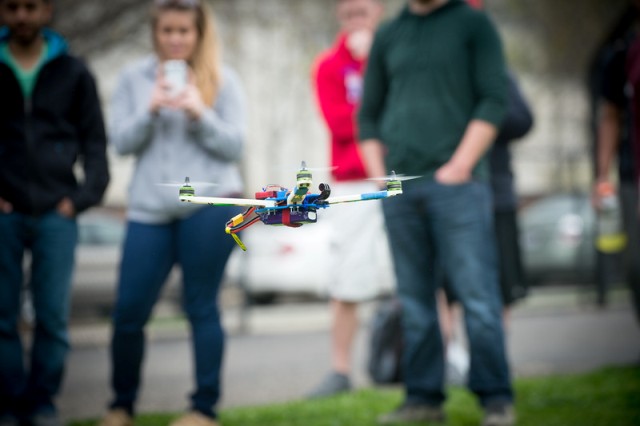May 5 2015
Indiana State University is not only flying unmanned aerial vehicles; these days some students are building them - from scratch.
 Students in an Indiana State University technology management class fly a quad copter made using 3-D printing April 14, 2015 ISU/Tony Campbell)
Students in an Indiana State University technology management class fly a quad copter made using 3-D printing April 14, 2015 ISU/Tony Campbell)
Two teams of students in a technology management class spent the spring semester designing a tri-copter and a quad copter and manufacturing parts using a three-dimensional printer. They then assembled the small aircraft and tested them at a campus athletic field.
The 3-D printer, which looks like an oven, complete with a window in the door, molds ABS plastic into shapes based on digital files the students create.
"Three-D printing has really been taking off recently," said Alister McLeod, assistant professor of applied engineering and technology management. "Manufacturers use it as a way to design new parts, to make things like aircraft lighter. They can print components instead of having to machine them and our students are leaving here and entering into a workforce that demands an understanding of these new technologies."
Grant Fultz of Lafayette, a senior mechanical engineering technology major who is also completing a minor in unmanned systems, was part of the quad copter team.
"We're trying to make something that's relatively cheap but still rugged and sturdy enough that it will fly well compared to the carbon fiber frames we could get from anyplace online," he said. "I'm doing this because that's the type of job I would want in the future."
Deontre Pearson, a senior automation and control engineering technology major from Fort Wayne, and a member of the tri copter team, said the class and its 3-D printing delivered on Indiana State's promise of experiential learning.
"We get the book material but we emphasize hands-on so we can not only calculate what we need to do but we can actually go out and do it," he said.
Such hands-on experience also gives students valuable troubleshooting practice, Pearson noted.
"One problem we had was with weight," he said. "We weren't sure how much the ABS plastic weighed so at the beginning our multi-rotor was too heavy and we had to redesign a couple of parts to get some weight off of it."Illustrating how quickly technology changes, Ashlyn Yocom, a senior technology management major from Terre Haute, took the class last year before the current 3-D printer was in place. An instructional assistant this year, she helped students in the industrial organizations and processes class convert their designs for use by the 3-D printer's software.
"It's extremely important to have these resources," she said. "You're going to start seeing 3-D printing in businesses and organizations everywhere. "To have it in the educational system and send students out knowing how to use it can only benefit them as well as organizations that they're going to be working for."
While both are in the College of Technology, the technology management class is not affiliated with the university's unmanned vehicles program, although Fultz, who transferred to Indiana State from Purdue University, is completing a minor in unmanned systems.
"There's not a lot of overlap between manufacturing engineering technology and aviation, but there is a lot of design work and they like to see that you're innovative and creative," Fultz said. "(In unmanned systems) I'm making a quad tilt rotor. That's something most of the aviation students don't have experience with but my engineering background allowed me to design that pretty well."
Unfortunately, when the day arrived for testing their creations at Wolf Field, adjacent to U.S. 41, winds played havoc. Both the tri-copter and quad-copter got off the ground and flew fine for a while before the blustery weather became too much. Both unmanned vehicles crashed but damage was minor.
The test flights attracted at least one student not connected to the College of Technology who came to see what was happening and he expressed amazement upon learning his fellow students had designed and built the aircraft they were flying.
"This class is a chance to push the bounds on what we are capable of doing and the new 3-D printer certainly made their journey much easier," McLeod said. "It shows them they shouldn't just accept the ordinary, they can do something extraordinary."
The 3-D printing experience has already opened some doors to career possibilities for the students from such potential employers as Rolls-Royce, Raytheon and GE.
"They've all contacted us about future jobs and I have an application with NASA going through right now," said Fultz.
For some, getting experience in managing projects was as valuable as experience using the latest in 3-D printing, perhaps even more so.
"Every part was made by a different person, so you have to communicate, ‘I'm going to use this motor,'" said Pearson. "You have to communicate that with the design engineers so they know how big to make the mounting holes. The communication part was the biggest think I've learned that's going to help me in the real world."
Contact: Alister McLeod, assistant professor, applied engineering and technology management and coordinator, manufacturing engineering program, College of Technology, Indiana State University, 812-237-3455 or [email protected]
Writer: Dave Taylor, media relations director, Office of Communications and Marketing, Indiana State University, 812-237-3743 or [email protected]